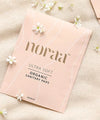Recent Post
Archive
- October 2021
-
- ARE PANTY LINERS SAFE FOR EVERYDAY USE? WHICH PANTY LINERS ARE ACTUALLY SAFE TO USE?
- CHEMICAL FREE SANITARY PADS: 3 WAYS THEY ARE REVOLUTIONARY
- NORAA – A CUSTOMER EXPERIENCE: LIFE BEFORE & AFTER USING ORGANIC MENSTRUAL PADS
- WHY EVERY WOMAN SHOULD KNOW ABOUT BIODEGRADABLE SANITARY PADS
- HOW ARE RASH FREE ORGANIC SANITARY PADS DIFFERENT FROM REGULAR PADS?
- HOW CAN RASH FREE SANITARY PADS HELP YOU FEEL BETTER DURING YOUR PERIOD?
- WHAT ARE ORGANIC – BIODEGRADABLE MENSTRUAL SANITARY PADS & WHY ARE THEY POPULAR?
- ORGANIC MENSTRUAL PADS: 8 BENEFITS YOU DIDN’T KNOW
- WHY DO YOU NEED NORAA RASH-FREE PADS NOW MORE THAN EVER?
- HEALTH CHOICES IN A PANDEMIC: HOW CAN ORGANIC FEMININE PRODUCTS HELP?
Tags

ORGANIC FEMININE HYGIENE PRODUCTS – A COMPLETE GUIDE
Chandrakant Bachhav
Oct 20, 2021
As many wise people continue to make the smart decision to “go green,” it’s no surprise that more brands are producing organic and environmentally-friendly & biodegradable versions of everyday products. Organic feminine hygiene products are becoming increasingly popular, but there are always doubts, as to whether they’re better for your health than traditional options.
Is the higher price tag typically associated with organic tampons and is the Organic feminine hygiene products worth it? We carefully looked at the difference between organic feminine hygiene products and the traditional ones as well as whether going organic is better for your health or not.
What’s the difference between organic and non-organic feminine hygiene products?
Traditional feminine hygiene products that most women are accustomed to are made with either traditionally grown cotton (meaning scary pesticides or insecticides were used), synthetic rayon (which aids in absorbency) or a mix of both cotton and rayon. Materials used in traditional tampons may also be treated with fragrances to control odour which is harmful. Applicators for traditional tampons are typically made of a smooth, pearly plastic that makes insertion easier but in the long term harm you.
Organic feminine hygiene products are made with cotton grown without pesticides or insecticides and are free of fragrances hence organic and also biodegradable. Applicators for organic feminine products are made from biodegradable materials, such as cardboard. They may also not come with an applicator at all.
The production process
The rayon used in traditional feminine hygiene products is made from cellulose fibres derived from wood pulp that only sounds great. According to the FDA, until recently, manufacturers would bleach the wood pulp, which would introduce trace amounts of dioxins into the material which could lead to health hazards.
Today, rayon is being produced using elemental chlorine-free or totally chlorine-free bleaching processes, significantly reducing the production of dioxins but not eliminating it, still harmful but lesser. The best feminine hygiene products that are totally chlorine-free may use hydrogen peroxide as a bleaching agent instead. Even though dioxins are typically introduced during the rayon production process, products made with 100 per cent organic cotton may also have very small amounts of dioxins, which are typically found in the air, water and soil, and can be introduced to the cotton any time during the growth process, however that is unavoidable.
All feminine menstrual hygiene products, whether organic or not, are regulated by the FDA and classified as medical devices. This means that no matter what material the products are made of, the absorbency levels must be consistent to meet FDA regulations that seek to reduce the risk of complications such as toxic shock syndrome (TSS) which is a relief. The FDA also requires all product manufacturers to monitor dioxin levels in their finished products.
Price and availability
Organic feminine hygiene products are becoming easier to buy in stores, but traditional products still make up the bulk of the current market and are easier to find and cost lesser. Organic products are also typically a bit more expensive than traditional ones and usually come in smaller packages and that might be a reason why people sacrifice their health so easily.
But are organic options better for your health?
While organic tampons are produced using fewer chemicals, there is no hard scientific evidence that suggests all-natural organic feminine hygiene products are any better for your health than regular varieties.
Although, in some of my research, a few companies are offering biodegradable applicators and bags and that reported as a process is safer for the environment.
While trace amounts of dioxins may be present in the hygiene products. We are already exposed to these toxins in our food supply, in the environment, and in household products. Some scientists have suggested that exposure to small amounts of these toxins can have a cumulative effect over your lifespan and obviously decrease it. The average woman uses around 11,000 feminine hygiene products during her lifetime. Meaning tampon use could theoretically increase your risk for diseases. This is caused by chemical exposure later on. But the chance is likely very small, also very scary.
If we are concerned about health risks, organic feminine products could buy peace of mind, at an increased cost, which may be worth it to most.
Some women may experience irritation of the vulva, called vulvitis, caused by fragrances and chemicals in traditional feminine hygiene products. In these cases, your gynaecologist will likely recommend switching to a non-fragrant product brand. Or opting for organic feminine hygiene products variety. Symptoms should clear up fully once the irritant is removed.
Overall, organic feminine hygiene products are a good choice for women seeking more natural options for their menstrual health – but they are not essential. It’s best to use whichever tampon and pad you’re most comfortable with because of your body, your choice. Consult your gynaecologist with any concerns you may have other than this.
Toxic shock syndrome
Many manufacturers of organic feminine hygiene products claim that the all-natural fibres lower your risk of developing TSS. A rare, but very serious complication caused by an overgrowth of bacteria called Staphylococcus aureus (staph). However, a recent study published looked at 11 types of tampons and four types of menstrual cups to know better. The kind of material – whether organic, regular cotton, rayon makes a difference when it came to the growth of bacteria.
It’s important to note that tampons are only associated with one in 100,000 cases of TSS. Which makes a tampon or a pad your last concern. These cases are usually due to improper tampon usage and probably for leaving it in for too long. Symptoms of TSS may include a sensation that your heart is racing, a lightheaded feeling, fever, and rash. Although TSS is severe, it is responsive to antibiotics and can be treated if caught early in time.
Safely using organic feminine hygiene products
Whether you use organic or regular pads, you should always use them safely. You can reduce the production of bacteria and your risk of TSS by changing your tampon and pad every two to three hours for a heavy flow and every three to four hours when your flow is lighter. You should never ever leave a tampon in overnight while sleeping. It’s also best to use the lightest absorbency possible to keep it fresh.
Avoiding scented feminine hygiene products can also reduce your risk of irritation, inflammation or allergic reactions overall.
It is important to find that organic feminine hygiene product that fits well to help reduce leakage and is safe to use at all costs.
← Older Post Newer Post →




